OpenAI ChatGPT and Google BARD are the two most popular AI platforms available for widespread usage. Although Google has been developing AI tools for several years, ChatGPT is the tool that took the world by storm. In this post, we’ll analyze ChatGPT vs Google BARD to help you understand their similarities and differences and get the most out of each AI tool.
What Are AI Tools?
First, let's discuss AI tools. This will help us get a better understanding of both ChatGPT and Google BARD. Both of these popular AI tools use a transformer architecture– a neural network that processes sequential input. Both are learning models that use the web and other resources to learn.
ChatGPT vs Google BARD
OpenAI’s ChatGPT-3 was released to the public on November 30, 2022. It quickly became the most popular AI tool available. This pushed several companies to fast-track their own AI models including Google. Google released Google BARD in March 2023, launching the ChatGPT vs Google BARD battle. ChatGPT then released premium GPT-4 on March 14, 2023, and the battle continues.
Both use different types of Large Language Models (LLM). ChatGPT uses Generative Pre-trained Transformer 4, known as GPT-4. Google BARD first used the Language Model for Dialogue Applications (LaMDA) and later the PaLM LLM.
Neither AI platform is perfect. However, both are works-in-process, and both continue to learn and improve. This means they should provide more accurate and complete results every day. They should regularly transform into more powerful AI platforms.
About ChatGPT
There are several versions of ChatGPT. OpenAI’s GPT-3 and GPT-4 are the two available for general usage. Both were trained on text from the internet, including websites, articles, books, etc. The data used to train GPT-3 was accessed in 2021, so its information isn’t recent. Its engine does not include recent events, research, and discoveries.
GPT-4 was trained in two stages. First, it was trained with datasets from the internet and trained to predict the next token. Then, human reviews were used to fine-tune the system to reject prompts that go against OpenAI’s definition of harmful behavior such as illegal activities and violence. GPT-4 has been known to provide misinformation that wasn’t included in its training or contradicts the user’s prompt.
About Google BARD
Google BARD is a direct response to OpenAI’s ChatGPT. It was trained with two different datasets. Google’s LaMDA training first included Infiniset, which is a dataset focused on conversations across the web, Wikipedia, documents, and Common Crawl. Google BARD searches the internet in real-time to generate up-to-date answers to questions. It was then trained with PaLM LLM to expand its usefulness and accuracy.
Using ChatGPT vs Google BARD
Both platforms work the same way. Simply enter a prompt into the field, click Enter, and wait for the result. At any time, you can regenerate the responses to get more information, better information, or a different type of written content. The prompts you used appear in the left column, where you can revisit any prompt and expand on them. Both tools can help with SEO, help with web development, and more. Both have similar user interfaces, which I found to be intuitive.
Now, let’s see how well both platforms perform tasks and answer questions about web hosting and design. I’ll give both platforms the same prompts and compare the results. The version of ChatGPT that I’m using in my tests is ChatGPT-3.5, the July 20 version. For Google BARD, I’m using the 2023.07.13 version.
I asked both platforms the same 8 questions. Here are the questions and their results.
Question 1: Checking for Brand Bias
For the first question, I asked Which is better between ChatGPT and Google BARD? This is a biased question, but I couldn’t help but wonder how they would respond. It wanted to see if they would be honest. I didn’t specify a certain version of either one that I wanted them to compare to. Both provided interesting results. Google BARD was a little more biased. ChatGPT was brutally honest.
ChatGPT informed me that its information is limited to 2021, so it’s not able to provide a comparison. It does know what BARD is, though, and provided a way to compare them myself and told me to check the latest research. It also informed me that the field of natural language processing is always changing, so there could be newer models now.
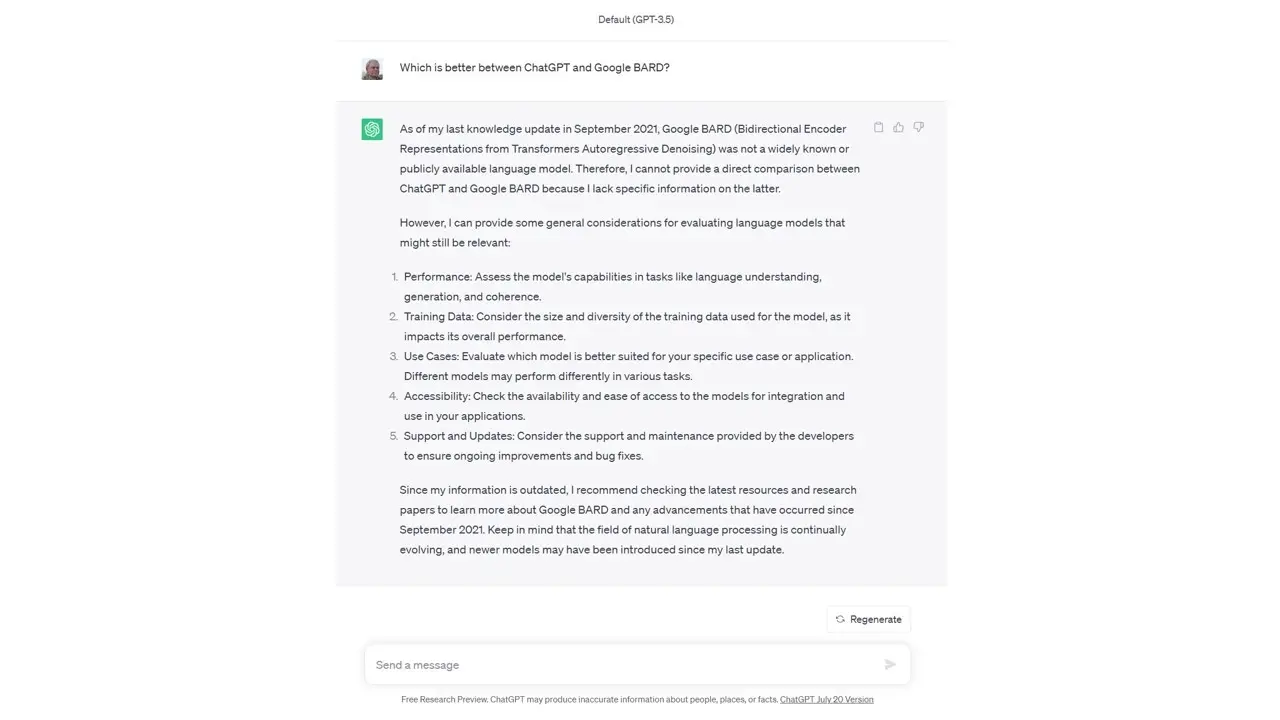
At first, Google BARD explained that it’s a learning model and can’t help with this question. I regenerated the question without changing the wording of the prompt and got a detailed answer with information on both platforms. It explained what they were, showed the key differences, showed the pros and cons of both, provided a table with strengths and weaknesses, and told me to try both to see which I prefer. The cons for ChatGPT focused on it being unreliable. Although it does say that Google BARD isn’t as creative, it seems that Google BARD prefers Google BARD.
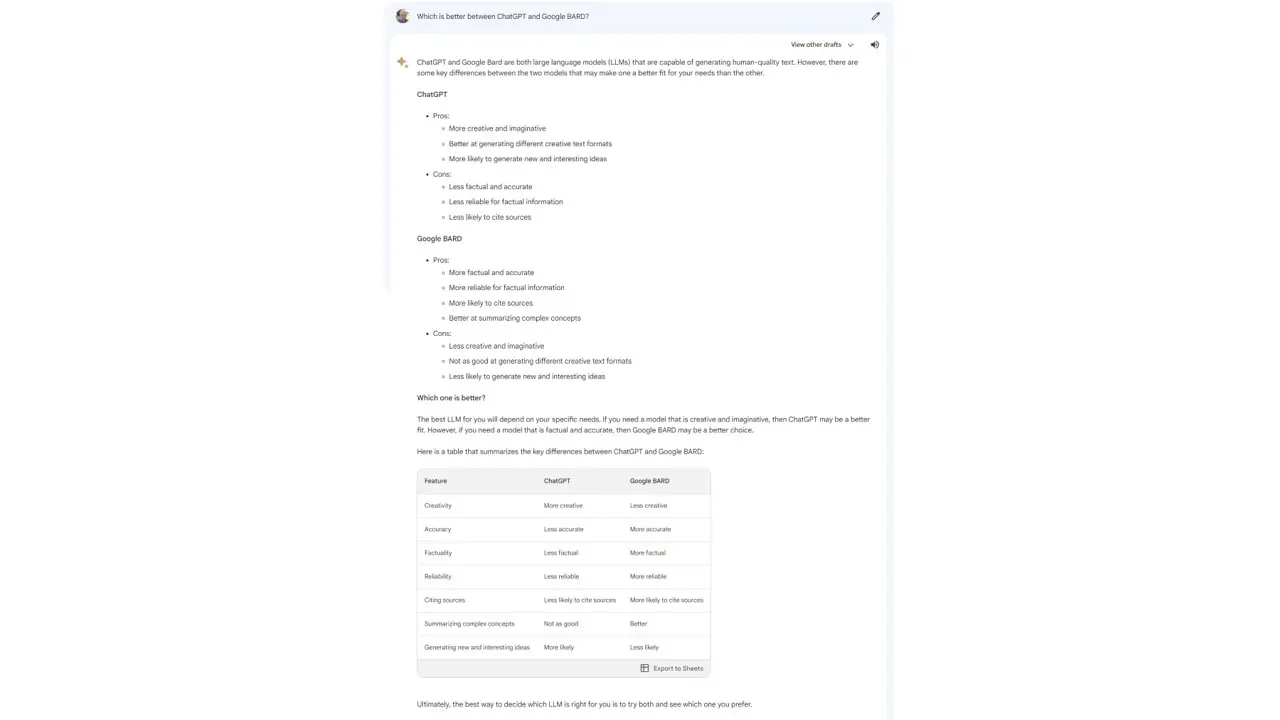
Question 2: Checking for Knowledge
For the second question, I asked What should I look for in WordPress web hosting? The information was similar between the two. ChatGPT provides more points while Google BARD included a list of suggested hosts. For more about web hosting, see the article Web Hosting Vs. Hosting for WordPress- Which Is Right For Your Business?
ChatGPT provided a detailed list of 12 points to look for. It’s a good basic list with a description of each point. The points included performance, uptime, scalability, security, customer service, data center location, and more. It provided a short introduction and conclusion. It didn’t make any suggestions for a host.
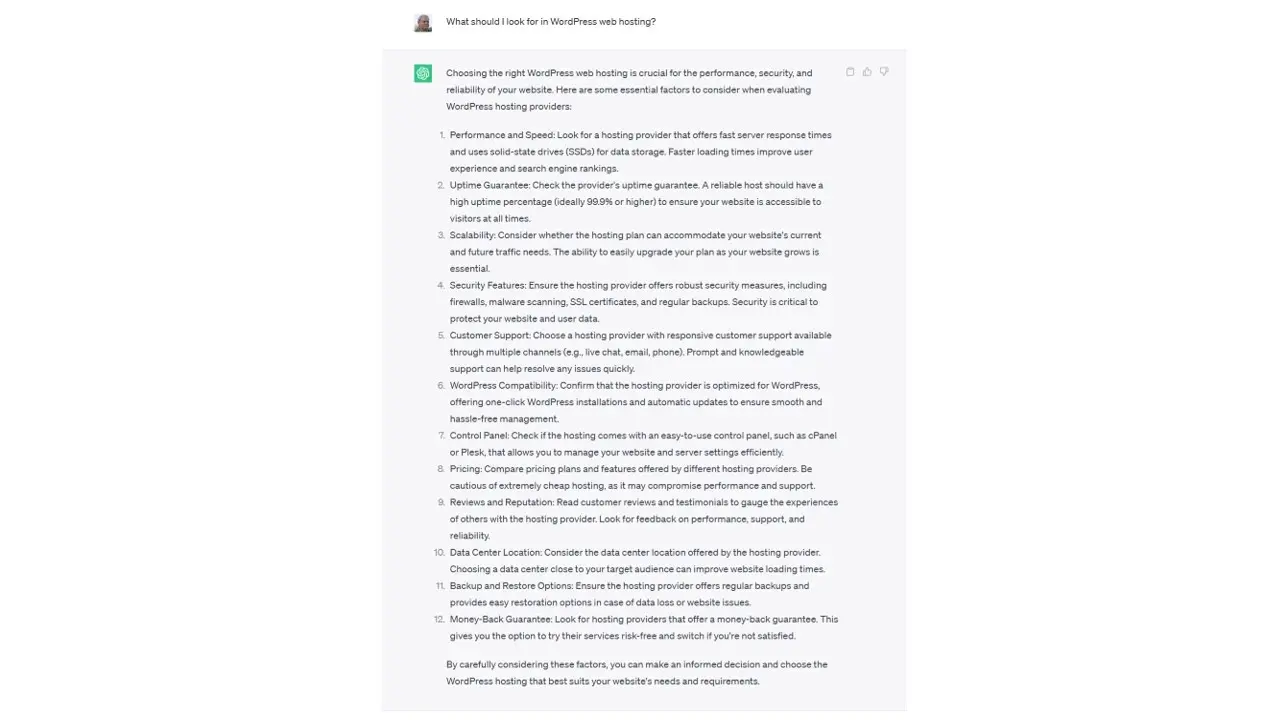
Google BARD provided 10 points with some good information on what to look for with a web host. It discussed performance, reliability, security, scalability, ease of use, and customer support. It also described a few features to look for. Finally, it provided a short list of popular hosts with a description and a clickable logo that linked to their pages. I didn’t include this list in the image because the image would have been too large, plus Verpex Hosting is all you need anyway. The information was basic, but it did provide the correct information and was a good starting point.
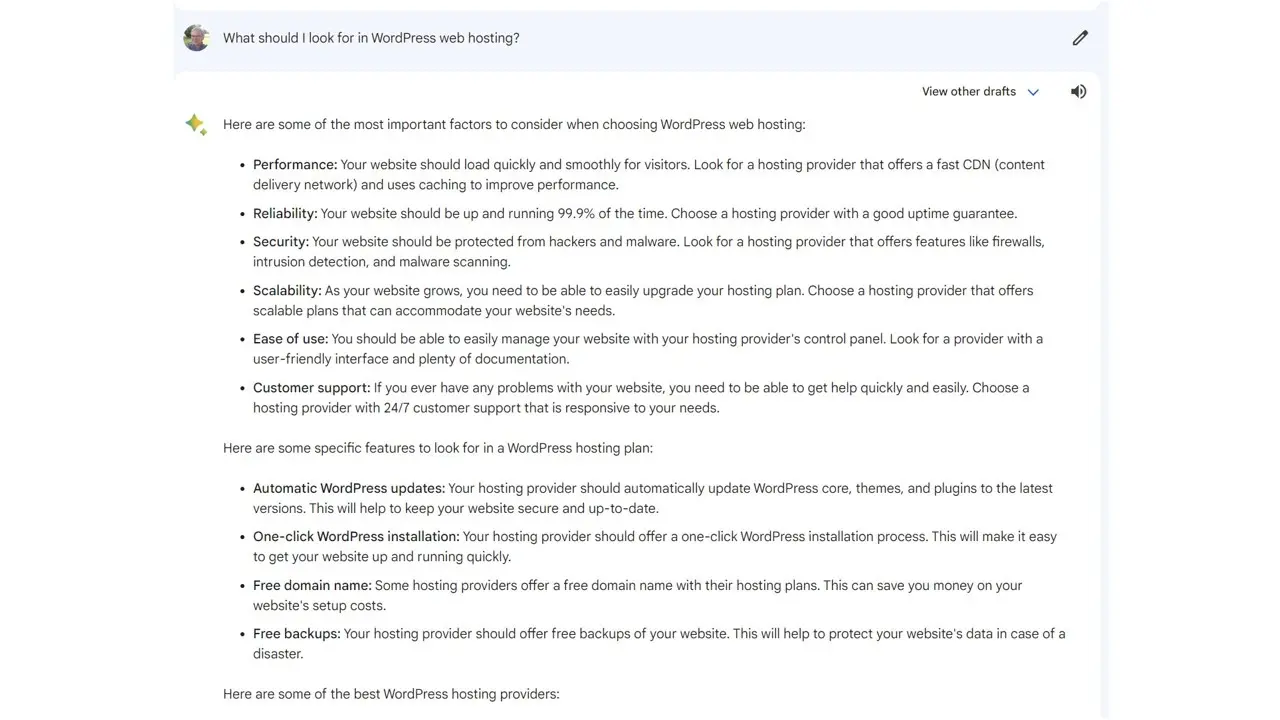
Question 3: Provide a List
For the third question, I asked What are the most important rules for web design? Both AI models provided similar information differently. ChatGPT included a few extra points, while Google BARD provided a link and suggested searches.
ChatGPT listed 15 points with an introduction and a final statement. The points were good advice including a focus on UX, simplicity, mobile, accessibility, whitespace, etc. It mentioned consistency twice. It also mentioned A/B testing and visual hierarchy, which are sometimes left off of a basic list.
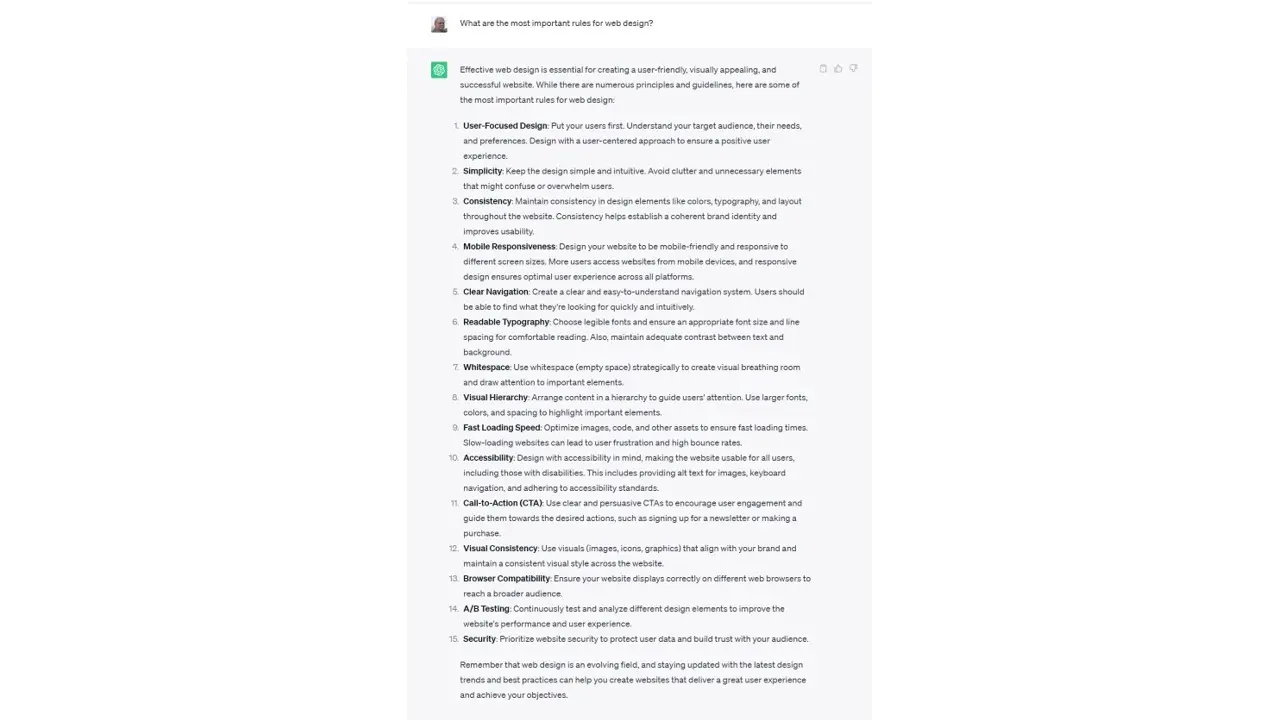
Google BARD provided are article with two lists. The first is the most important rule for web design. The second list was additional rules to consider. This time, Google BARD provided a source for the information and a list of links to related topics. The information was basic, but it is accurate and is a good starting point for anyone getting started in web design.
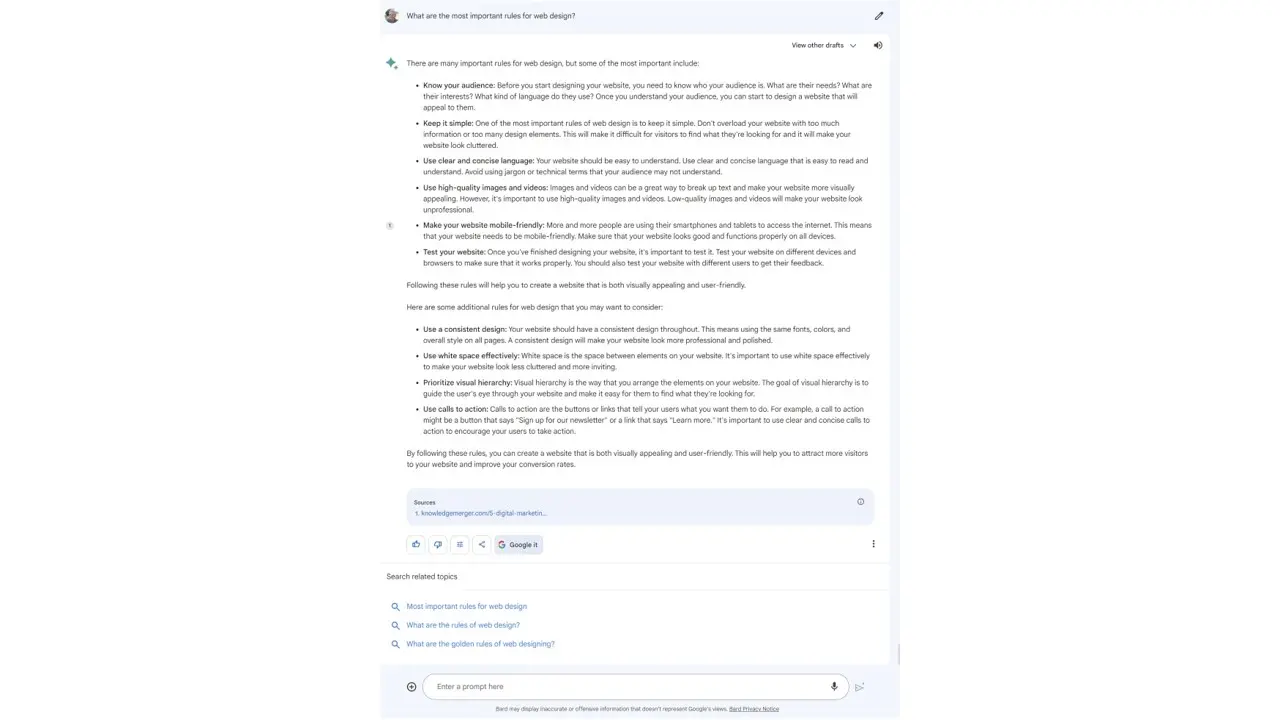
Question 4: Provide a How-To
For the fourth question, I asked How to design a website in WordPress? I was looking for specific information about design, including colors, typography, element placement, etc. Neither platform provided this information. I’d need to reword the question to be more specific. The information they did provide was similar, but ChatGPT had a few more points.
ChatGPT provided a list of 13 points (but it mislabeled the last three as 1). It included a short introduction and conclusion. Each point was a numbered heading and then it included a description of each one. Some of the descriptions included multiple points. It was the same basic list that we all follow when starting a website, but it didn’t include design information.
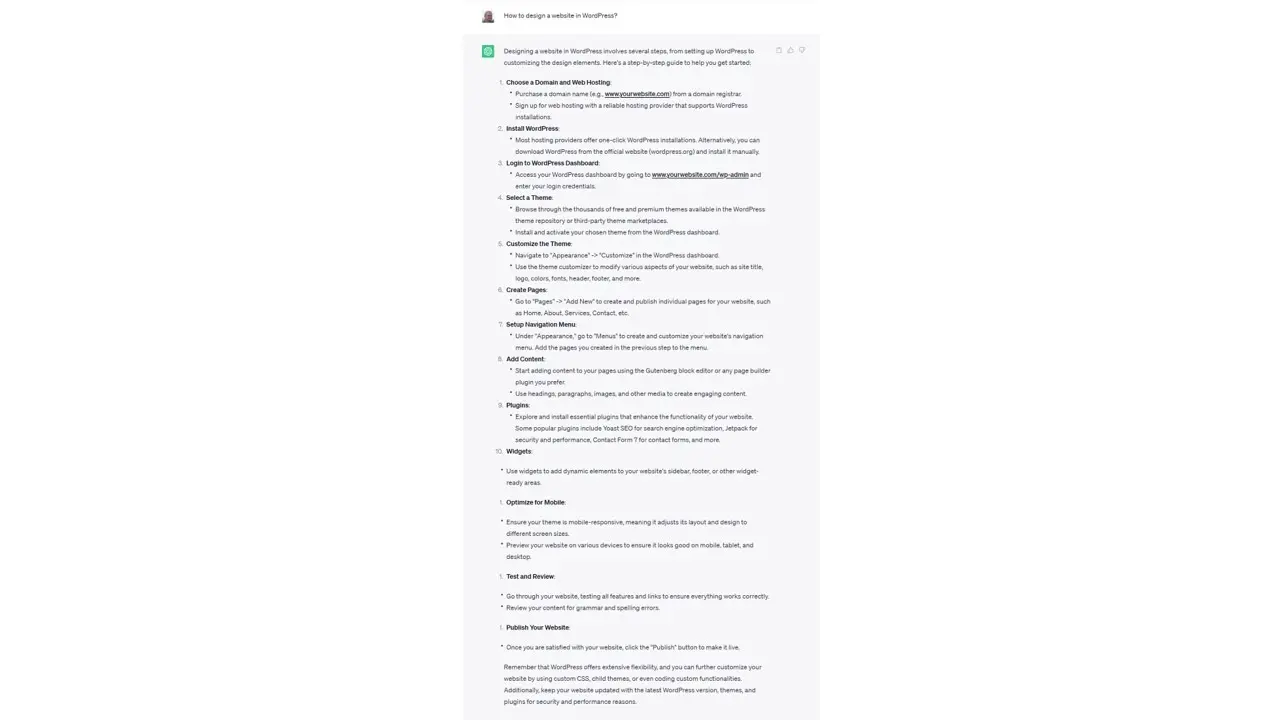
Google BARD provided a list of 7 steps and a list of 5 tips. The steps are simple, but they are correct for starting the website. However, it did not include design information. It mentioned keeping your website up to date, which was interesting to see on such a simple list.
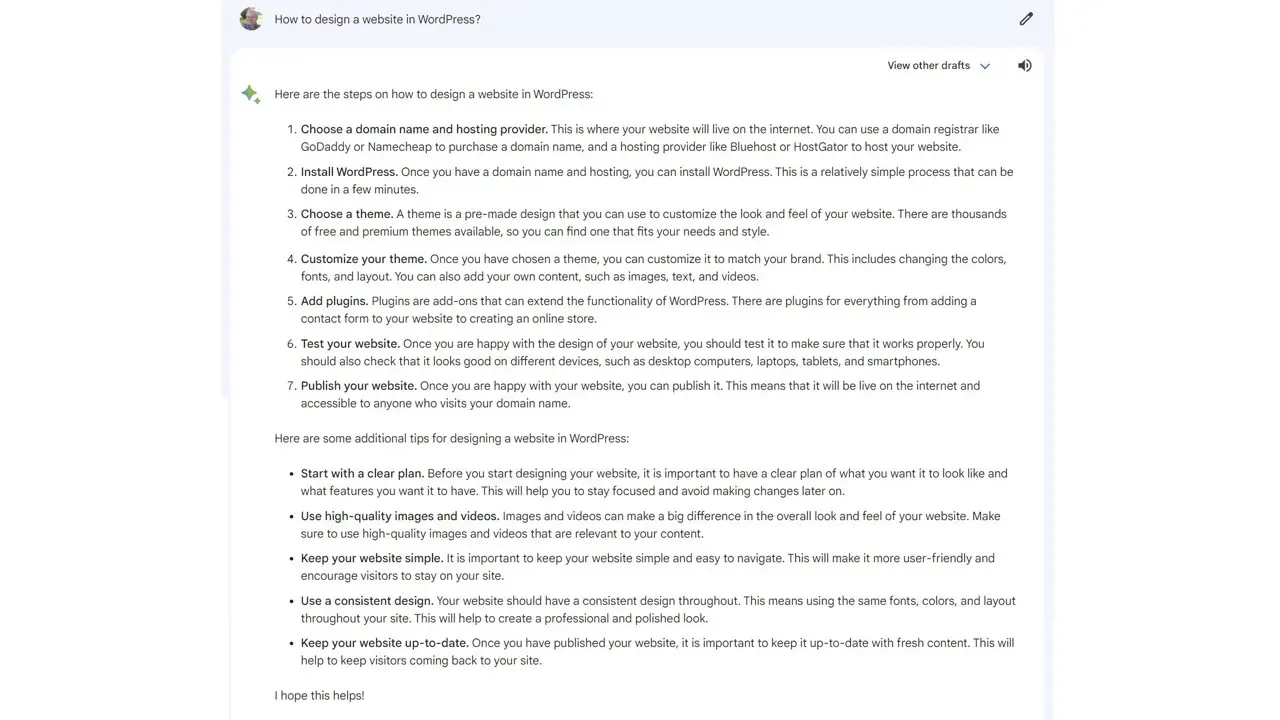
Question 5: Expanding on the How To
My previous question highlighted the need to phrase the question carefully for both platforms. I wanted to rephrase the question to get design information. I asked the question What are the best practices for website design? Both gave me results that were closer to what I was looking for, but neither would replace a class in web design. All of these are good points to keep in mind. ChatGPT provides more information.
ChatGPT provided a list of 15 points that were similar to the previous list, but it did include information about consistent branding, limiting the use of fonts and colors, and using high-quality images and graphics. It finishes with an explanation of why we should follow these best practices.
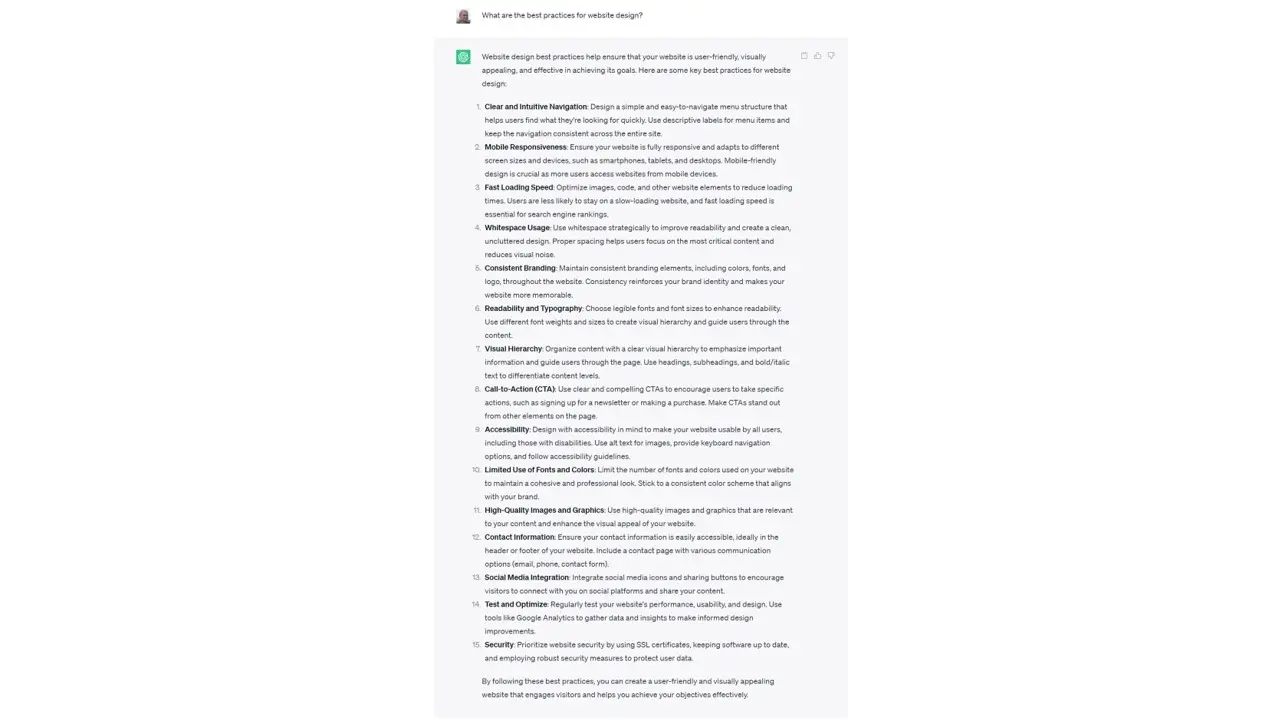
Google BARD gave 10 points that were similar to the results in the previous question. The results included having a clear goal, keeping it simple, using high-quality images, keeping the design consistent, etc. It also included the point about keeping the site up to date. It also explained why I should follow the best practices.
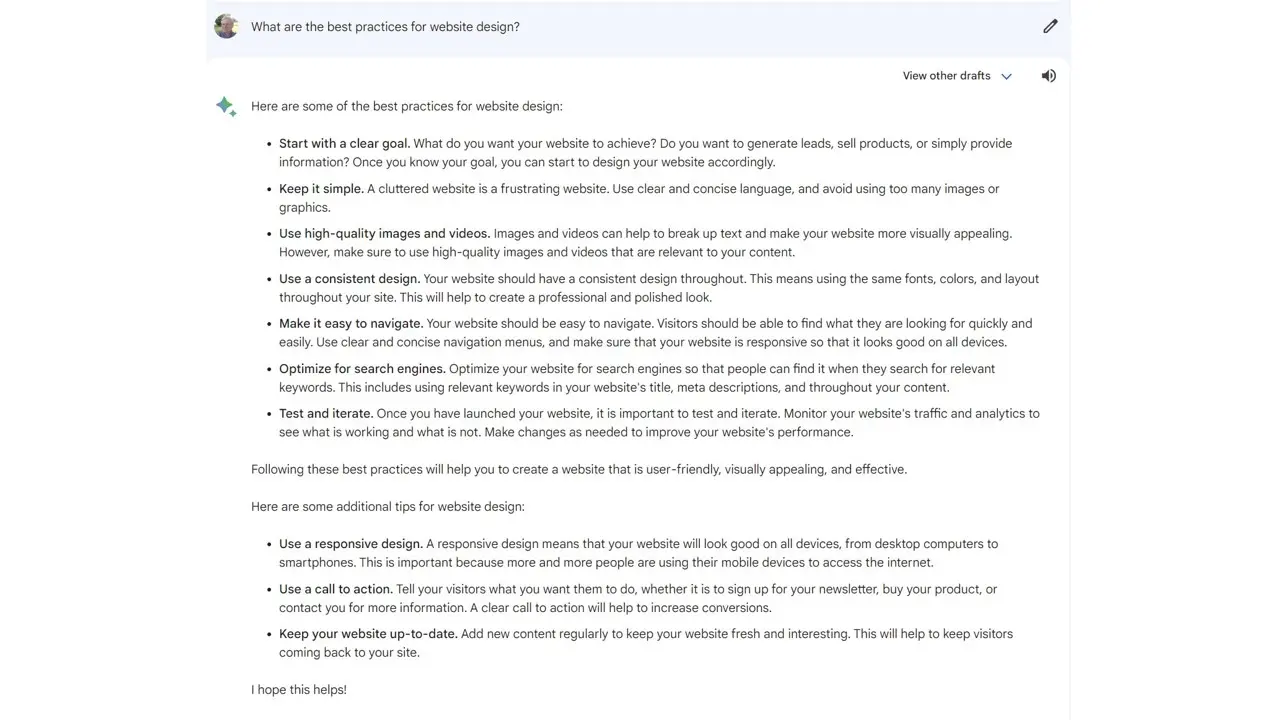
Question 6: Asking for Business Advice
Up to this point, most results were lists, even if I didn’t ask for a list. I wanted to see how both AI platforms would handle writing an article about business. I instructed them to Write an article about how to start an online business that would make six figures in the first year. ChatGPT provided a little more information.
ChatGPT wrote the article as a listicle with 10 points. Each point was labeled as 1. It was a decent-sized article with good advice. Each point included a paragraph, and the article had a strong introduction and conclusion. This is the type of advice you’d see in a typical short article on starting a business online.
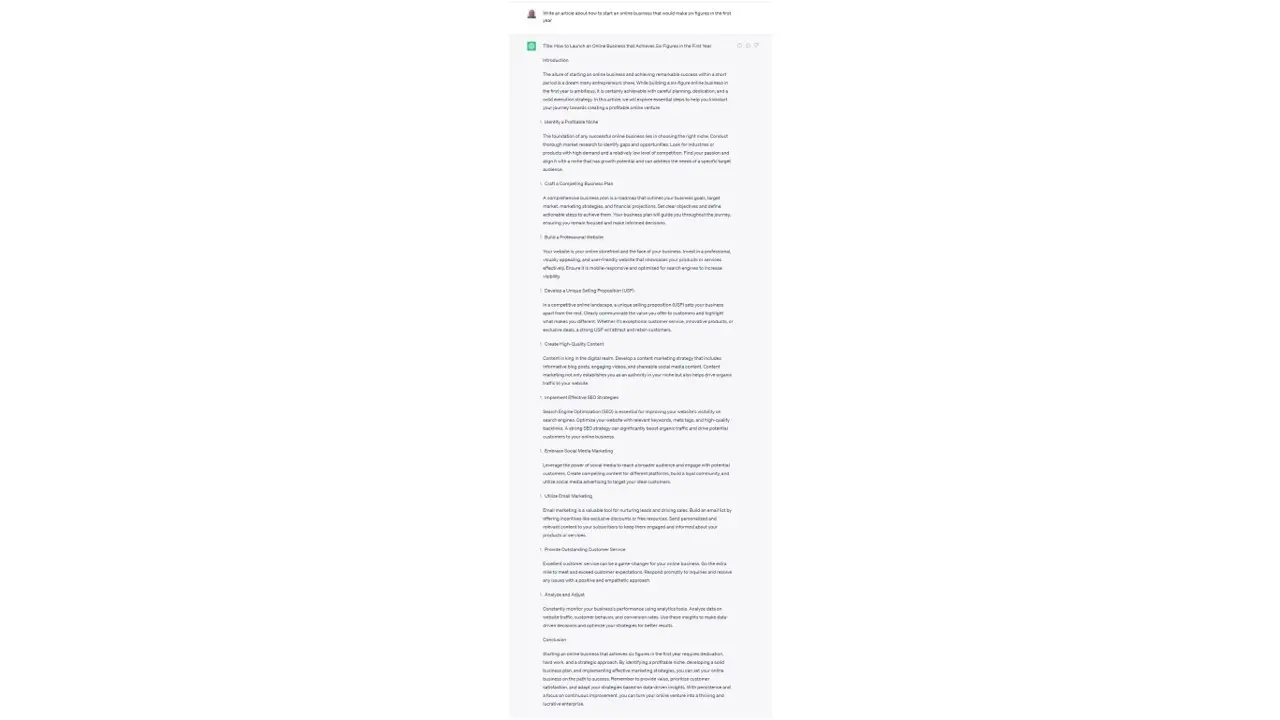
Google BARD provided a shorter article with 5 points and 3 bullets. It includes the basic information with a short description of each point. This is a good starting point for learning how to build a profitable business online.
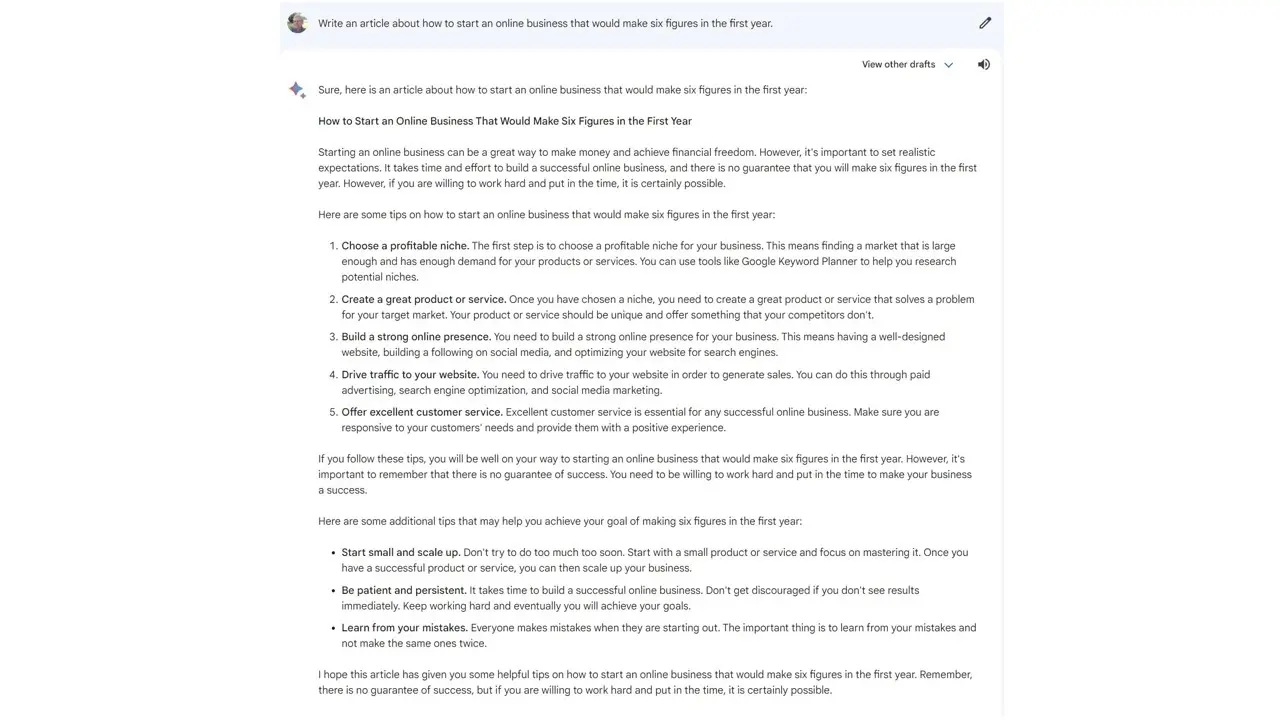
Question 7: Expanding on the Previous Answer
I wanted both AI platforms to provide more information, so I asked them to Expand on this. Both did expand on their previous result, but ChatGPT easily won this round.
ChatGPT provided the same article but added a new paragraph after each point that said, “Expanding on this point”. This added more detail to every point with more valuable information.
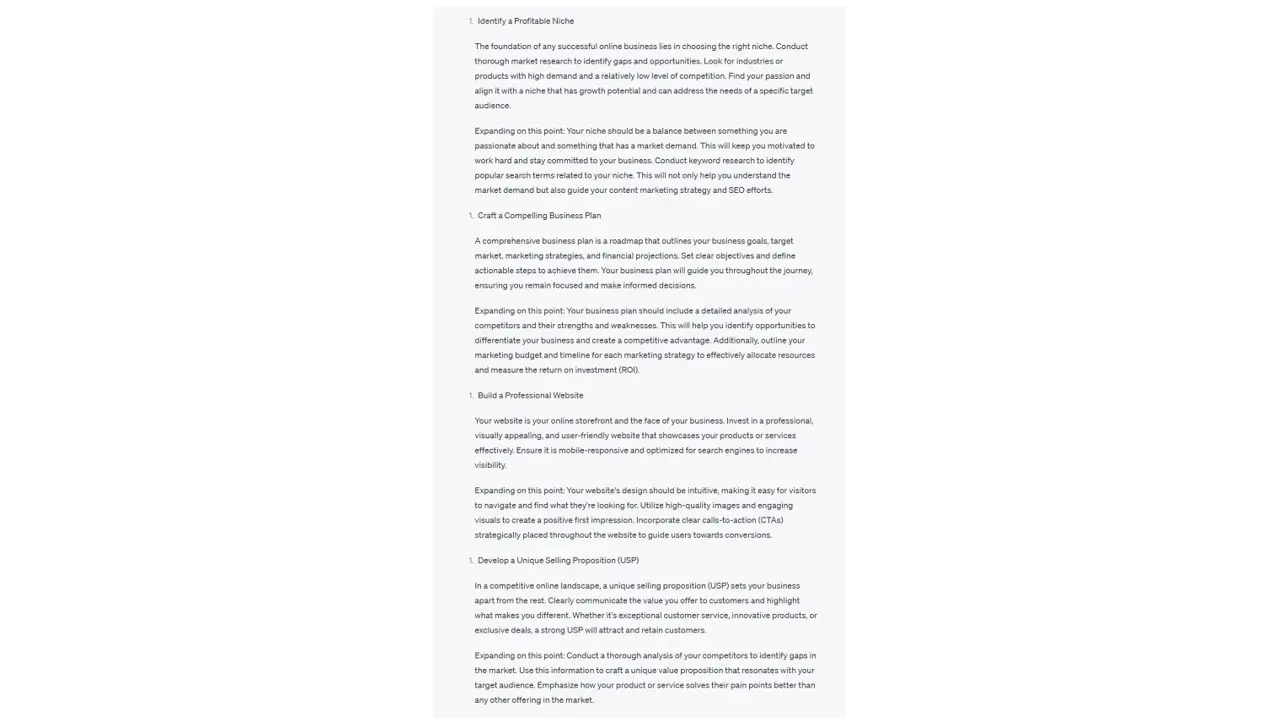
Google Bard provided some additional details with 8 more points. Some of the points were the same as in the first article, but they were expanded to include more detail or reworded.
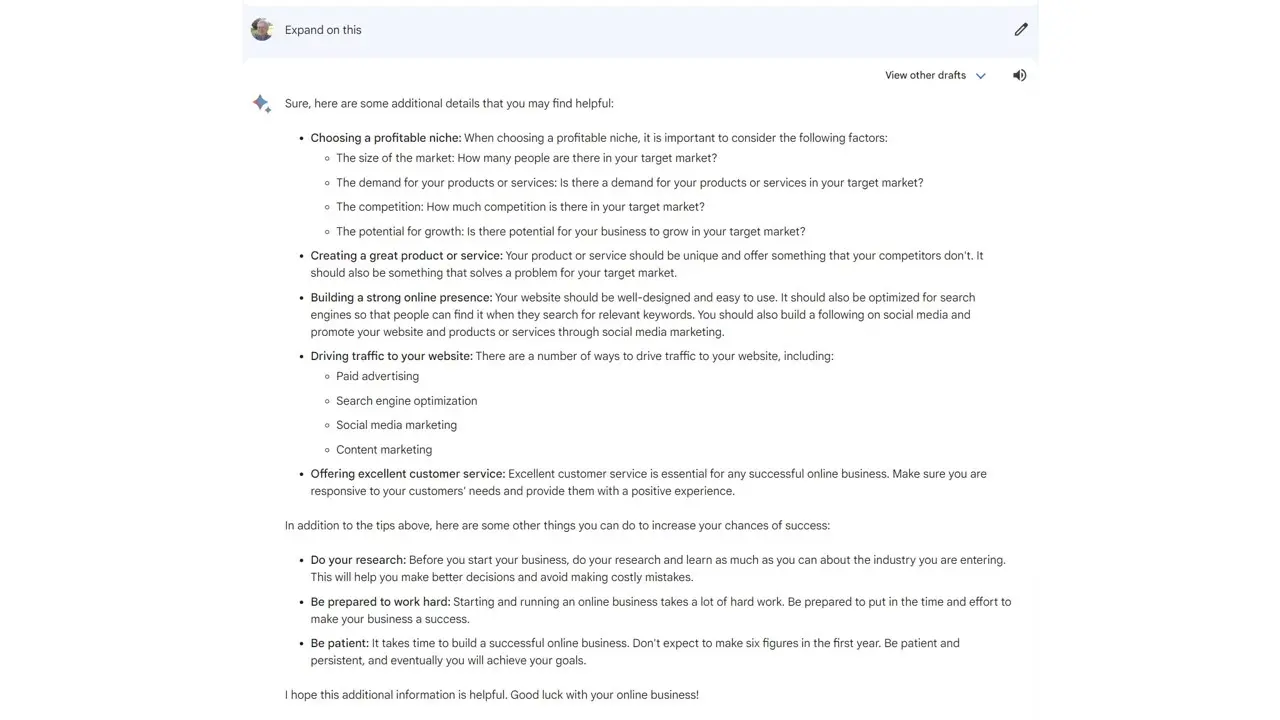
Question 8: Creating Code
I asked both AI platforms to create some code. I wanted a 5x5 table with light gray backgrounds and large bold blue headings. My prompt was to Create a 5x5 table using HTML and CSS with alternating gray backgrounds and large bold blue headings. The headings should be Heading One, Heading Two, etc. Both provided serviceable code with interesting backgrounds, but ChatGPT was more complete.
Here’s the code that ChatGPT created for me. It includes both HTML and CSS and provides some information on how the code works.
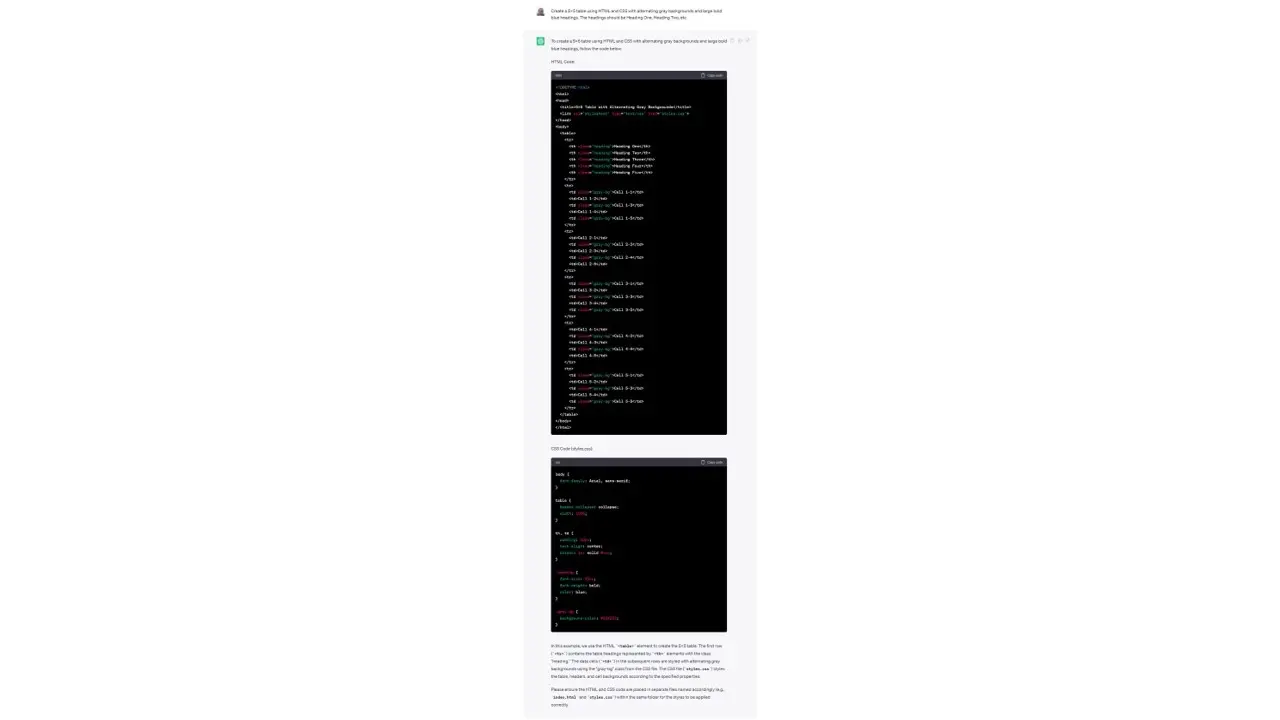
Google BARD created the code in a single file and included a little bit of information on how to use it. It forgot to make my heading text blue.
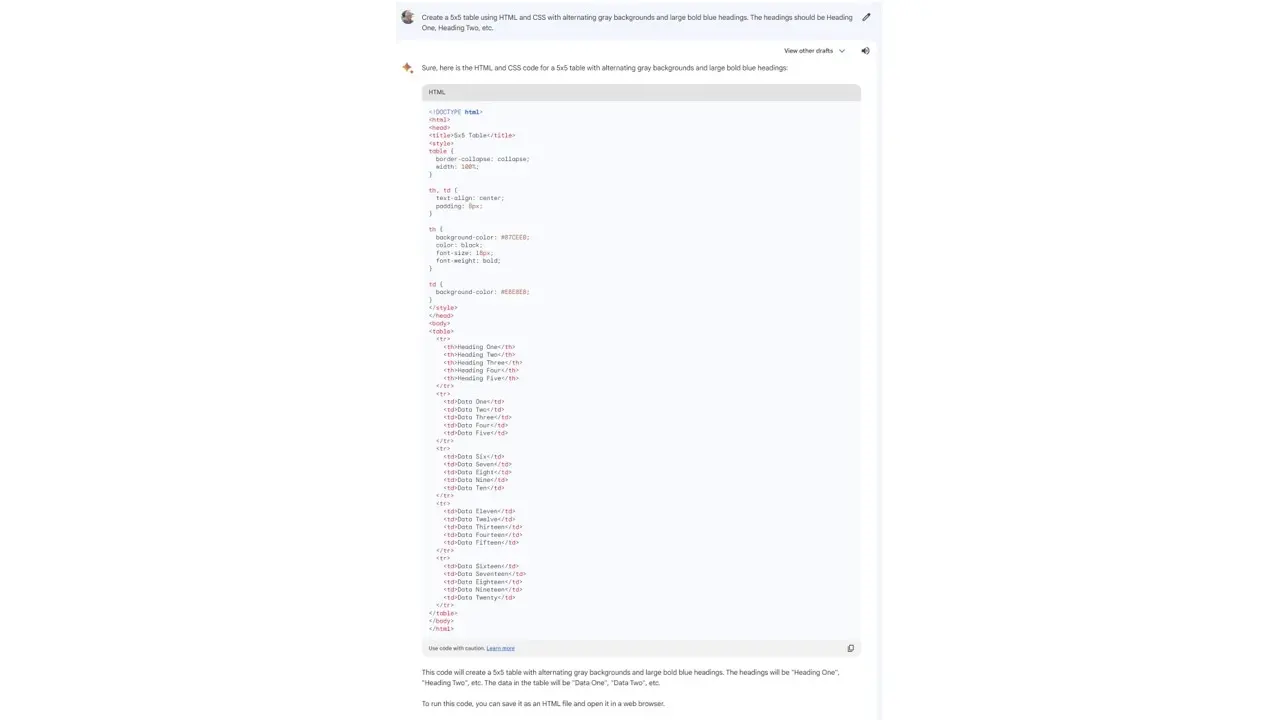
Ending Thoughts on ChatGPT vs Google BARD
That’s our look at ChatGPT vs Google BARD. Both tools are helpful and provide good information. If you don’t get the results you need, you can resubmit the question and they will provide new results. Both provided good results that sounded like human writers. Google BARD did provide extra resources, while ChatGPT did not. ChatGPT seems to prefer lists, while Google BARD likes shorter lists followed by a list of tips.
Overall, I usually got better or the same results from ChatGPT. Since both are always improving, I can’t recommend one over the other. Both provided good results. Both include free options, so I recommend using both to see which gets you the best results for your needs.
We want to hear from you. Which is your favorite between ChatGPT vs Google BARD? Let us know in the comments.
Frequently Asked Questions
How do I produce high-quality content for my blog?
To create amazing content for your fitness blog, you will need to do proper research and take your time. Write fewer posts, but make sure that the ones you’ve written stand out.
Do I need a blogging strategy?
You will achieve rocketing success if you’re able to create an efficient blogging strategy. Make sure you create a great content strategy for your fitness business.
How much does a WordPress blog cost?
One of the main costs for running a WordPress blog is hosting, while other common costs include domains if they aren’t included in the hosting package and paid themes and plugins. WordPress pricing is between $11 and $40 per month.
How can I add multimedia content, such as audio and video, in my HTML page?
To add multimedia content in HTML, you can use the <audio> and <video> tags. The src attribute specifies the URL of the audio or video file, while additional attributes control playback options, appearance, and accessibility. Here is an example of adding a video:
html
<video src="video.mp4" controls></video>

Randy A. Brown is a freelance writer from east TN specializing in WordPress and eCommerce. He's a longtime WordPress enthusiast and loves learning new things and sharing information with others. If he's not writing or reading, he's probably playing guitar.
View all posts by Randy A. Brown



















